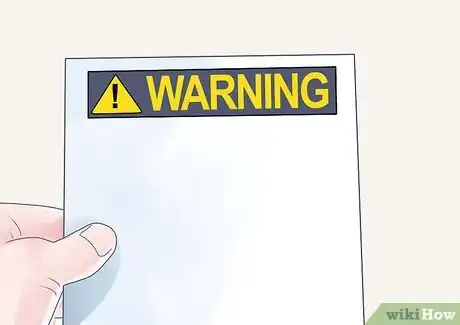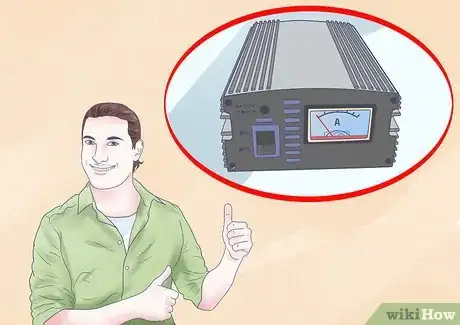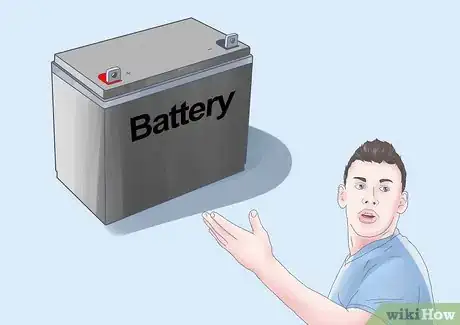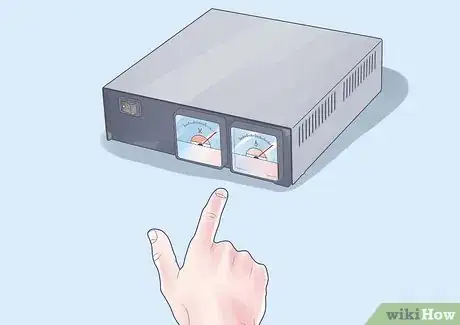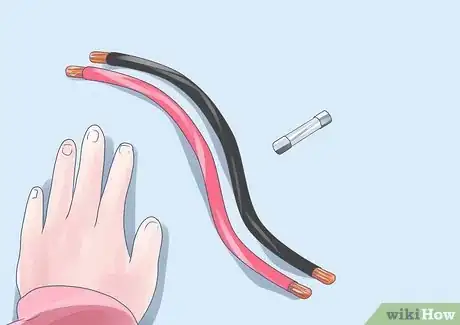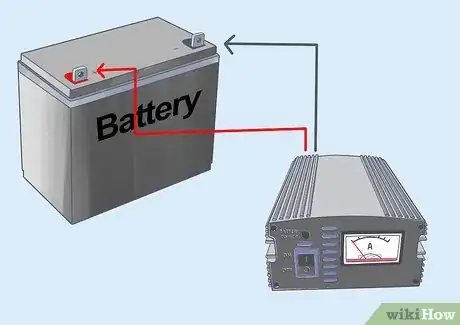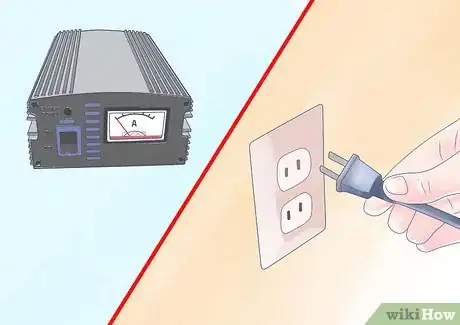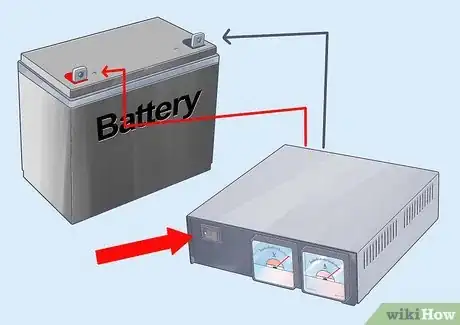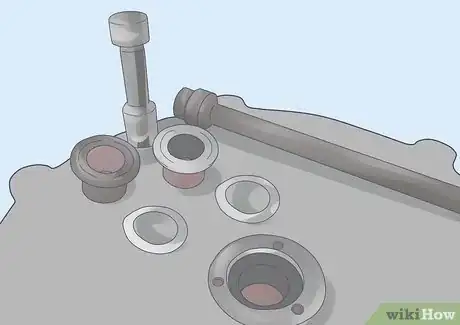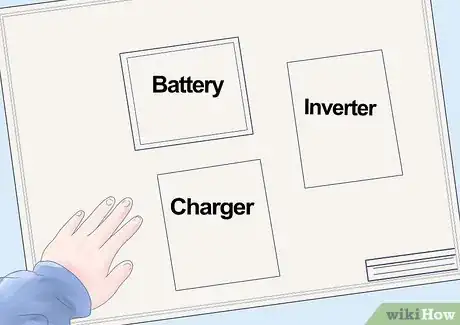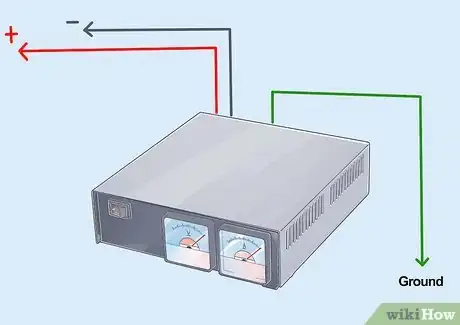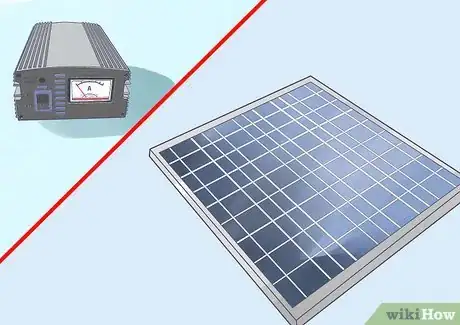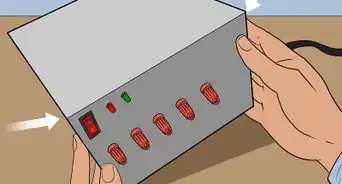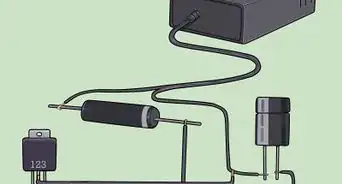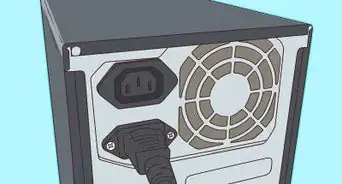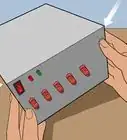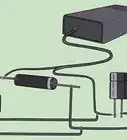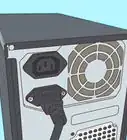wikiHow is a “wiki,” similar to Wikipedia, which means that many of our articles are co-written by multiple authors. To create this article, 28 people, some anonymous, worked to edit and improve it over time.
This article has been viewed 605,541 times.
Learn more...
In the event of extended blackout, you may have critical systems (such as computer or medical equipment) that must remain running no matter what. This guide will yield one scalable uninterrupted power supply system. You may extend it with power generation, or solar/wind/etc. as you see fit.
Most uninterrupted power supplies sold for computers 'switch' power, running a small inverter when power is interrupted, then switching back to 'normal' power when it's back on. This one simply produces AC power with a continuous duty inverter and assumes some system(s) will charge the DC battery supply it requires faster than it consumes it. This makes the design simpler and also allows more than one kind of DC power source to participate in charging the batteries. Your UPS system here will be an online type.
Steps
-
1Read all warnings before proceeding. This is for your safety.
-
2Choose a charger that can supply enough current to charge the battery and keep up with the inverter's load. This will be a fairly heavy duty charger.
- Check RV suppliers for 'Converters', designed to run larger RVs if you are making a big system.
- Check solar power sources for "big" whole house chargers and inverters for very large systems.
- If an RV or home converter has an inverter built in, make sure it's isolated (or can be isolated) from the input power.
- Make sure the charger handles the kinds of batteries you are going to buy.
Advertisement -
3Choose only deep cycle batteries. Do not use a car or truck battery, nor a 'marine' battery. If you will be using only one battery, a gel or 'maintenance free' battery will work adequately. For larger systems composed of multiple deep-cycle batteries, select only wet cells or AGM cells.
- Make sure the batteries are ventilated for escaping hydrogen gas.
- If you buy wet cells, make sure the charger supports an 'equalize' charge.
- Lead acid batteries are sold in 6 volt and 12 volt sizes. You will need to connect them in series to raise the voltage, or in parallel to increase the amp-hours available.
- 12 volts = 2x6V volt batteries connected in series
- 24 volts = 4x6V or 2x12V batteries in series
- When connecting series-parallel, connect pairs of batteries in parallel and then connect those pairs in series, not chains of series batteries in parallel.
- Do not mix different kinds of batteries. Newer batteries added to existing sets of batteries will be as worn as the originals very quickly.
- In larger series-parallel setups it's a good idea to swap batteries around every year or so.
- Batteries that are shallowly drained (cycled) will last a long time, while batteries that are deeply cycled will have shorter lives.
- A fully charged, new 12 volt battery is 12.6 volts at rest (each of six cells is 2.1 volts).
- A fully charged, new 6 volt battery will be at 6.3 volts at rest.
- When a 12 volt charger is operating on it, the voltage will be higher. A float charge (maintenance charge) for a 12 volt system is 13.5 to 13.8 volts; active charging requires at least 14.1 volts. You may see it go as high as 16 volts when charging, depending upon the charger. After a full charge, if the battery is not going to be float charged, the at-rest voltage will slowly return to the nominal full-charge voltage.
- A discharged 12 volt battery is 11.6 volts at rest. A discharged 6 volt battery is 5.8 volts at rest. The voltage may temporarily fall below these levels while powering a large load, but should return to a point within the nominal range after a 1-hour rest. Over-discharging to less than 1.93 volts per cell at rest will permanently damage your battery.
- Batteries can be measured with a voltmeter for an approximate state of charge, but many dead batteries can hold a 'shallow charge' which drops off rapidly when current is drawn. You'll need to test them with a 'live' load over a series of hours to verify them.
- A regulated 12 volt power supply can not fully charge a discharged 12 volt battery, but it makes a good float charger if the output voltage is correct (again, 13.5-13.8 volts for a 12 volt system). Check the water level in the cells often, and replenish as needed with distilled water.
-
4Choose an inverter.
- Rated for continuous duty at substantially more power than you think you'll need.
- Enough 'peak' current to handle motor starting loads, which can be from 3 to as much as 7 times the rated running wattage.
- Inverters are available for input voltages of 12, 24, 36, 48, and 96 volts, and a few less common voltages. The higher the voltage the better, especially for large systems. 12 volts is the most common, but in no case should one consider 12 volts for a system of greater than 2400 watts output (The amount of current that has to be handled is simply too high).
- Some of the better inverters have a built-in 3-stage automatic battery charger and transfer relay, greatly simplifying the system. These inverters are well worth the extra money; if fact they save money overall, as the built-in charger is a bargain compared to the price of a comparable stand-alone charger.
-
5Get cables and fuses and other hardware to interconnect batteries, charger and inverter.
- These should be very heavy gauge,[1] well made, and as short as you can fit it all together with. This is to keep the cable resistance low.
- Consider spending just a bit more for a bus bar interconnect with big dividers, instead of just 'wires everywhere'. It is tidy and helps prevent accidental shorts. It also makes it easier to remove defective batteries.
-
6Wear protective gear and observe safety precautions.<br.>
- Don your eye protection to protect against acid splashes to the eye.
- Wear protective, non-conductive gloves if possible.
- Remove any jewelry and any metallic items you might be wearing.
-
7Securely attach the charger cables to the deep cycle battery, noting polarity.
-
8Prepare the charging system. Plug the charger into the wall and power it on. Make sure it begins a proper charge cycle, and make sure the inverter is powered off.
-
9Attach and test the inverter if it is separate from the charger. Hook up the cables to the batteries, noting polarity. Turn the inverter on and test it with some suitable AC load. You shouldn't see sparks, smoke, or fire at any point. Leave the inverter on with a load similar to your planned load and allow the battery to charge overnight. This will test that the charger and load are a good match. In the morning, the battery should be fully charged.
-
10Dismantle the test rig.
-
11Design a tidy enclosure. This could be shelves in a shed, or a very large container. This will hold the batteries, charger, and inverter. Generally the charger and inverter should not be right next to the batteries where escaping gas can get to them. If so, it can shorten the life of the electronics, or ignite gases from sparking if vents are blocked. Some partition should be installed and separate air circulation should be provided for the charger and inverter. Alternatively, mount the charger/inverter outside the battery box. Once ready, install the components into it.
-
12Make the connections. Runs of cable should be kept fairly short. You need easy access to every battery to check, so clean and tighten cables. For wet cells, you need to be able to easily take every top off to check fluid levels and get distilled water into them. Make sure the inverter is grounded. You may ground it to the ground wire on the charger's input AC, or use a grounding rod driven into the soil.
-
13Supplement alternatives where beneficial or necessary. You may supplement or replace the charger with solar, wind, etc., connected to their own applicable charge controller. This can keep the power running far longer than it otherwise would, even indefinitely. Also, you may supplement the charger with a generator. Attach a truck alternator to a small internal combustion engine, use a generator with 12 volt charging output, or unplug the charger from its AC outlet and then use a 'regular' AC generator to power the charger.
- The UPS can be located outside.
- Install an inside and outside outlet through a wall connected only to each other. You can plug the UPS inverter into the outside outlet (with a 'gender bender' extension cable) to power the inside outlet.
- Disconnect and isolate an indoor circuit from the main circuit breaker panel. Route the wire out of that box through one of the punch-outs or remove it, and connect it to the inverter, providing conduit to shield as applicable. All plugs/lights/smoke detectors/etc. on that circuit will be powered by the UPS, so test and make sure nothing 'extra' is connected to it.
- Run conduit and/or get fancy as you see fit, relative the permanence of your solution.
- The UPS can be located outside.
Expert Q&A
-
QuestionHow do I test my generator's output?Mantas SilvanaviciusMantas Silvanavicius is a Licensed Electrician and the Owner of M+S Electric based in Las Vegas, Nevada. With more than 20 years of experience, he specializes in home electrical installations, testing, and wiring. Mantas and his team have completed projects for companies such as Seiko and Springhill Suites by Marriott. M+S Electric is licensed, bonded, and insured.
Licensed ElectricianTo test your generator's output, connect a multimeter to the generator output and measure for voltage. Check the instructions that come with your multimeter for more details. -
QuestionIf I increase the amp/hr of a battery, can I use it to power a ready-made UPS inverter?
 Community AnswerSure, you can always increase/decrease the amount of energy a premade UPS holds as long as the battery/-ies are the same voltage and the cable you use to connect them to where the original battery was is suitable for the current.
Community AnswerSure, you can always increase/decrease the amount of energy a premade UPS holds as long as the battery/-ies are the same voltage and the cable you use to connect them to where the original battery was is suitable for the current. -
QuestionMy USP inverter charges the batteries, but they get too hot. What can I do?
 Community AnswerThere's likely a short somewhere. Double-check everything and isolate parts of the system if necessary to troubleshoot.
Community AnswerThere's likely a short somewhere. Double-check everything and isolate parts of the system if necessary to troubleshoot.
Warnings
- There is enough DC current in a battery bank to stop your heart.⧼thumbs_response⧽
- The AC output from the inverter is identical to mains power and can kill you.⧼thumbs_response⧽
- Grounding the inverter is not optional, it is a must. Remember to obey local regulations regarding grounding, especially if only one grounding rod is allowed per site.⧼thumbs_response⧽
- Shorting batteries can cause blinding flashes, blow wrenches into splinters, even cause the batteries to explode and spray sulphuric acid and hunks of plastic everywhere.⧼thumbs_response⧽
- Wear eye protection when working on batteries.⧼thumbs_response⧽
- Do not wear watches or jewelry when working on the batteries.⧼thumbs_response⧽
- If you're not familiar with electrical safety regulations, don't try any of this.⧼thumbs_response⧽
- The DC current from the battery can burn you. A ring that gets between 'hot' wires can amputate your finger.⧼thumbs_response⧽
- Don't mess with the circuit breaker panel if you're not a really very good (and very, very safe) electrician.⧼thumbs_response⧽
- Wearing shoes is recommended.⧼thumbs_response⧽
- If power goes to outside outlets or near water, either buy an inverter with a Ground Fault Interrupt and ground it, or add a GFI to it.⧼thumbs_response⧽
- Provide proper ventilation for batteries. Trapped hydrogen gas can ignite and/or explode.[2]⧼thumbs_response⧽
Things You'll Need
- One or more deep cycle batteries
- One battery charger (at the voltage of the battery bank, and matching battery chemistry)
- One heavy duty inverter
- Battery cables
- Eye, face, and hand protection (for handling batteries)
